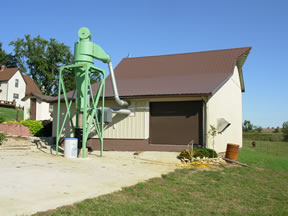Q.
What's the difference between a one stage and two stage dust collection system, and how do I determine which system is best for my shop?
Forum Responses
Since most woodworking dust contains coarse and fine sized particles, a two-stage dust collection system is generally recommended. A two-stage dust collector consists of a first stage cyclone, a blower and a second stage after filter.
A cyclone separator is a cone shaped vessel into which the dust-laden air enters. The dust particles' inertia causes them to move toward the separator's outer wall. As the dust particles proceed toward the outer wall, the coarse-sized particles lose momentum. When the velocity drops on the coarse-sized particles, gravity causes them to settle into the container below. The remaining fine dust exits through a central outlet at the top and into the blower. The blower then relays the fine dust to the after filter. It is important to know that the longer the cyclone body and cone, the better the dust separation.
One major reason for using a separator is so the blower unit will only convey fine dust. In a single stage unit, coarse wood dust particles and other debris hitting the blower impeller most likely will result in blower unbalance. The condition will ruin the blower quickly. Also, a separator is used so that the after filter does not receive 100% of the dust-laden air.
Curt Corum, forum technical advisor
